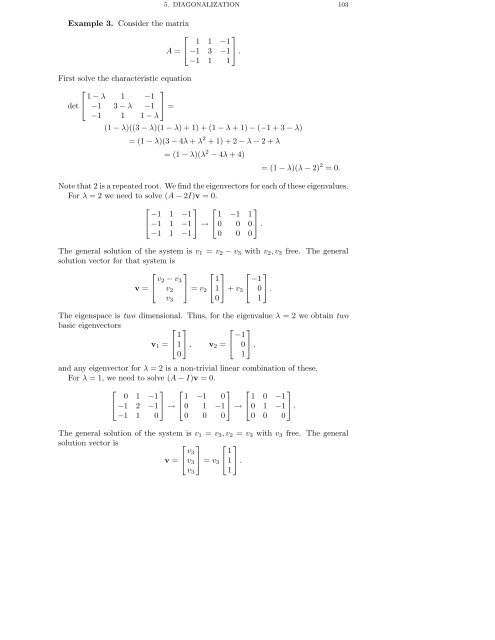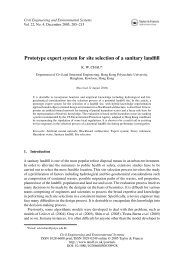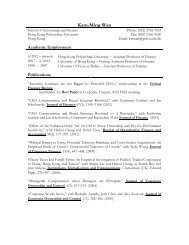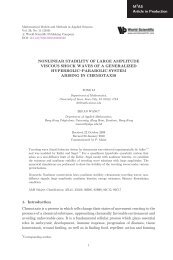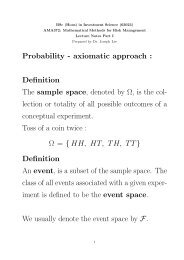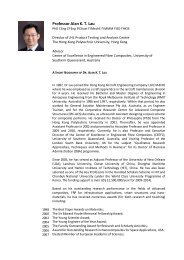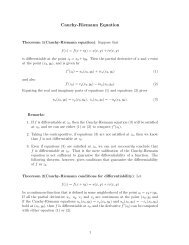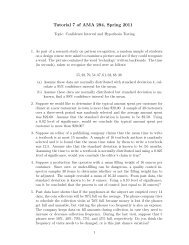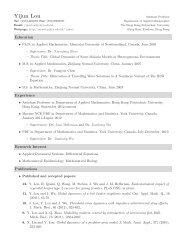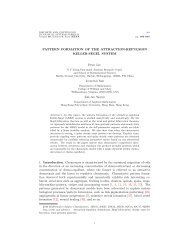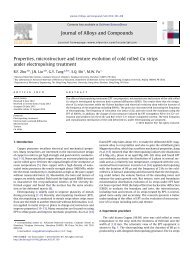DETERMINANTS AND EIGENVALUES 1. Introduction Gauss ...
DETERMINANTS AND EIGENVALUES 1. Introduction Gauss ...
DETERMINANTS AND EIGENVALUES 1. Introduction Gauss ...
You also want an ePaper? Increase the reach of your titles
YUMPU automatically turns print PDFs into web optimized ePapers that Google loves.
5. DIAGONALIZATION 103Example 3. Consider the matrix⎡A = ⎣ 1 1 −1⎤−1 3 −1⎦.−1 1 1First solve the characteristic equationdet⎡⎣ 1 − λ −1 1 3−λ −1−1⎤⎦ =−1 1 1−λ(1 − λ)((3 − λ)(1 − λ)+1)+(1−λ+1)−(−1+3−λ)=(1−λ)(3 − 4λ + λ 2 +1)+2−λ−2+λ=(1−λ)(λ 2 − 4λ +4)=(1−λ)(λ − 2) 2 =0.Note that 2 is a repeated root. We find the eigenvectors for each of these eigenvalues.For λ = 2 we need to solve (A − 2I)v =0.⎡⎤ ⎡−1 1 −1⎣−1 1 −1⎦ → ⎣ 1 −1 1⎤0 0 0⎦.−1 1 −1 0 0 0The general solution of the system is v 1 = v 2 − v 3 with v 2 ,v 3 free. The generalsolution vector for that system is⎡ ⎤ ⎤ ⎤v =⎣ v 2 − v 3v 2v 3⎦ = v 2⎡⎣ 1 10⎦ + v 3⎡⎣ −1 0 ⎦ .1The eigenspace is two dimensional. Thus, for the eigenvalue λ = 2 we obtain twobasic eigenvectors⎡ ⎤ ⎡ ⎤v 1 = ⎣ 1 1 ⎦ , v 2 = ⎣ −1 0 ⎦ ,01and any eigenvector for λ = 2 is a non-trivial linear combination of these.For λ = 1, we need to solve (A − I)v =0.⎡⎤ ⎡⎤ ⎡ ⎤⎣ 0 1 −1⎣ 1 −1 0⎣ 1 0 −1−1 2 −1−1 1 0⎦ →0 1 −10 0 0⎦ →0 1 −10 0 0The general solution of the system is v 1 = v 3 ,v 2 = v 3 with v 3 free. The generalsolution vector is⎡v = ⎣ v ⎤ ⎡3v 3⎦ = v 3⎣ 1 ⎤1 ⎦ .v 3 1⎦.


